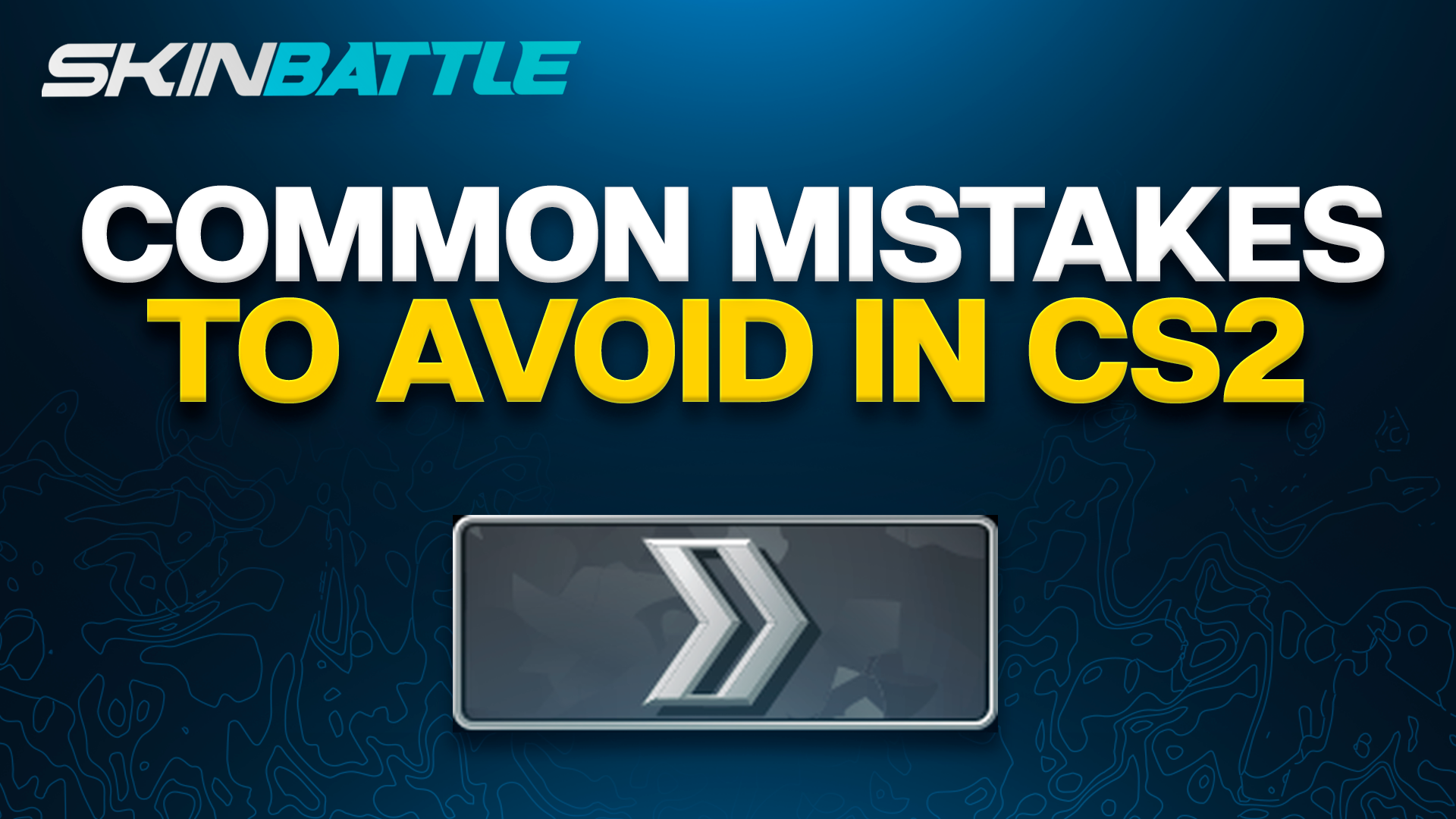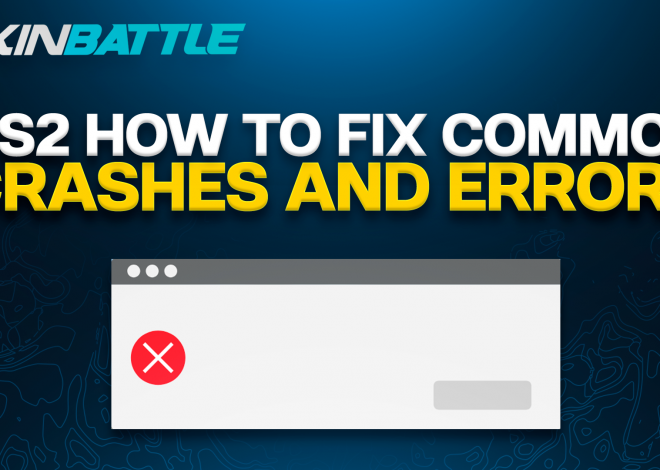
Common Mistakes to Avoid in CS2
Welcome to the world of Counter-Strike 2 (CS2), where winning isn’t just about being a sharpshooter. It’s also about avoiding common mistakes that can trip you up along the way. While many guides focus on fancy tricks, this article is all about the little slip-ups that can mess with your game.
We’re here to shine a light on these often overlooked errors, why they happen, and how to steer clear of them. Whether you’re a new recruit or a seasoned pro, knowing these pitfalls can make a big difference in your gameplay.
So, let’s take a closer look at the blunders to sidestep in CS2. By learning from these mistakes, you’ll be better equipped to navigate the challenges of the game and come out on top. Let’s dive in!
Poor Crosshair Placement
One of the most fundamental aspects of CS2 gameplay is crosshair placement. It may seem like a small detail, but where you position your crosshair can make all the difference between landing that perfect headshot or missing your mark entirely.
The mistake of poor crosshair placement often stems from a lack of awareness and anticipation. Many players tend to aim at the ground or keep their crosshair at head level, regardless of the situation. However, in CS2, the key is to always keep your crosshair where you anticipate enemies to appear.
To avoid this mistake, players should develop a keen sense of map awareness and enemy positioning. By studying common engagement points and anticipating enemy movements, you can preemptively position your crosshair in areas where enemies are likely to appear. This proactive approach not only increases your chances of landing shots but also reduces the time needed to react to enemy threats.
Additionally, maintaining proper crosshair placement while navigating the map is essential. Whether you’re clearing corners or holding angles, always ensure that your crosshair is positioned at head level and ready to react.
Neglecting Map Awareness
Map awareness is a critical skill in CS2 that is often overlooked but can greatly impact your gameplay. Neglecting map awareness can leave you vulnerable to enemy attacks and put your team at a disadvantage. Let’s explore some common mistakes related to map awareness and how to avoid them:
- Failing to Check Radar: The radar provides valuable information about enemy positions and teammate locations. Neglecting to glance at the radar regularly can result in missed opportunities and surprise attacks.
- Ignoring Callouts: Team communication is essential in CS2, and ignoring callouts from teammates can hinder your ability to anticipate enemy movements. Pay attention to callouts and act accordingly to support your team’s efforts.
- Lack of Map Knowledge: Not knowing the layout of the map and common chokepoints can leave you vulnerable to ambushes and flanks. Take the time to learn the maps thoroughly to better anticipate enemy movements and position yourself strategically.
- Tunnel Vision: Focusing too narrowly on your immediate surroundings can lead to a lack of awareness of what’s happening elsewhere on the map. Stay aware of the bigger picture and be ready to adapt your strategy based on changing circumstances.
- Overextending: Pushing too far into enemy territory without considering potential threats from other areas of the map can leave you isolated and exposed. Maintain awareness of your surroundings and avoid overextending without proper backup.
Mismanagement of Economy
- Buying Without Consideration: Many players fall into the trap of buying expensive weapons and equipment without considering the implications for their team’s economy. This can leave them short on funds for future rounds and disrupt the team’s overall economy.
- Eco Rounds: Neglecting to play eco rounds when necessary can also be a costly mistake. Eco rounds involve saving money by purchasing cheaper weapons and minimal equipment to build up funds for future rounds. Failing to play eco rounds when behind in economy can prolong the team’s financial struggles.
- Lack of Coordination: Poor communication and coordination within the team can result in inconsistent buying strategies. Some players may buy when others are saving, leading to disparities in equipment and hindering the team’s effectiveness in coordinated pushes.
- Overcommitting to Buys: Conversely, players may also overcommit to buys, spending all their money on expensive equipment when it’s not necessary. This can leave them vulnerable in subsequent rounds if they lose the current one.
Overextending and Overcommitting
In the heat of the moment, it’s easy to get carried away and push too far or commit too heavily to a fight in CS2. However, overextending and overcommitting can often lead to disastrous consequences for both individual players and their teams. Here’s why it’s important to avoid these common mistakes:
- Leaving Yourself Vulnerable: Overextending can leave you isolated from your team and vulnerable to enemy attacks from multiple angles.
- Wasting Resources: Overcommitting to a fight can result in unnecessary expenditure of ammunition, utility, and equipment, leaving you ill-prepared for subsequent engagements.
- Feeding the Enemy: Continuously overextending or overcommitting can feed kills to the enemy team, allowing them to snowball their advantage and dominate the match.
- Loss of Map Control: Overextending can lead to loss of map control, allowing the enemy team to gain ground and dictate the flow of the game.
To avoid overextending and overcommitting, it’s essential to maintain awareness of your surroundings, communicate effectively with your team, and exercise restraint when engaging with enemies. By staying disciplined and strategic in your approach, you can avoid falling victim to these common pitfalls and contribute more effectively to your team’s success in CS2.
Lack of Communication
Communication is the lifeblood of teamwork in CS2, yet the importance of effective communication is often underestimated. Beyond simply relaying information, effective communication fosters cohesion, enhances decision-making, and promotes synergy among team members.
One commonly overlooked aspect of communication is the quality of information exchanged. It’s not just about conveying raw data but providing context, intention, and clarity. Vague callouts or incomplete information can lead to misunderstandings and missed opportunities, while concise and precise communication can streamline decision-making and improve team coordination.
Furthermore, communication isn’t just about talking but also about active listening. Players should be receptive to the information shared by their teammates, whether it’s callouts, strategies, or feedback.
Ignoring Recoil Control
Recoil control is a fundamental skill in CS2 that is often overlooked or underestimated by players. It refers to the ability to manage the recoil generated by firing weapons, which can significantly affect accuracy and effectiveness in combat.
One common mistake is neglecting to practice recoil control for different weapons, leading to inconsistent aim and missed shots. For example, failing to compensate for the recoil pattern of the AK-47 or the M4A4 can result in bullets spraying wildly and failing to hit the intended target.
Another mistake is relying too heavily on aim rather than recoil control. While precision aiming is important, it’s equally crucial to master recoil control to maintain accuracy during sustained firefights. For instance, continuously spraying with an SMG at long range without controlling recoil can result in ineffective damage output and wasted ammunition.
Ignoring recoil control not only diminishes individual performance but also undermines team success. Players who fail to manage recoil effectively may struggle to secure kills or hold positions, leaving their teammates at a disadvantage in crucial engagements.
Tunnel Vision
Tunnel vision is a common mistake that plagues many CS2 players, often leading to missed opportunities and costly errors. It refers to the tendency to become overly focused on a single objective or aspect of gameplay, while neglecting peripheral information and situational awareness.
For example, a player may become fixated on holding a specific angle or engaging with an enemy, failing to notice flanking opponents or incoming grenades. This narrow focus can leave them vulnerable to ambushes and expose their team to unnecessary risks.
Additionally, tunnel vision can hinder decision-making and adaptability during matches. Players who are too narrowly focused may struggle to react to changing circumstances or adjust their strategies in response to enemy movements.
Failing to Adapt Strategies
Failing to adapt strategies based on the evolving circumstances of the game can lead to missed opportunities and ultimately, defeat. Here are some reasons why players may fall into this trap:
- Lack of Flexibility: Some players may become overly attached to a particular strategy or tactic, even when it’s not yielding results. This inflexibility can make them predictable and easier for opponents to counter.
- Ignoring Enemy Adjustments: Failing to recognize and respond to the strategies employed by the opposing team can put your team at a significant disadvantage. Ignoring enemy adaptations allows them to gain the upper hand and dictate the flow of the game.
- Refusing to Experiment: Players who are unwilling to experiment with new approaches or tactics may find themselves stuck in a rut. Embracing innovation and creativity can breathe new life into stale strategies and catch opponents off guard.
To avoid the pitfalls of failing to adapt strategies, players should remain open-minded, observant of enemy movements, and willing to experiment with different tactics.
Conclusion
In conclusion, mastering CS2 requires more than just sharp reflexes and precise aim; it demands a keen awareness of common mistakes and a commitment to avoiding them. By understanding the significance of these errors and taking proactive steps to address them, players can elevate their gameplay and contribute more effectively to their team’s success.
Remember, success in CS2 isn’t just about individual skill; it’s also about teamwork, adaptability, and strategic thinking. By avoiding common mistakes like poor communication, tunnel vision, and failing to adapt strategies, players can become more well-rounded and formidable competitors.



Hi, this is a comment.
To get started with moderating, editing, and deleting comments, please visit the Comments screen in the dashboard.
Commenter avatars come from Gravatar.